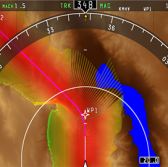 Rockwell Collins and NASA have begun to integrate new functionalities into the sonic boom display prototype to preview impacts and develop modifications to flight plans in an effort to help pilots reduce the risk of sonic boom impacts on the ground.
Rockwell Collins and NASA have begun to integrate new functionalities into the sonic boom display prototype to preview impacts and develop modifications to flight plans in an effort to help pilots reduce the risk of sonic boom impacts on the ground.
Development work on the prototype continues after NASA and the company demonstrated a sonic boom visualization platform during a usability test and a pilot working group meeting in March as part of the two-year Sonic Boom Display project, Rockwell Collins said Friday.
NASA and Rockwell Collins also explore the areas of weather data and architecture related to supersonic flight in addition to the project’s sonic boom avionics display aspect.
The company has collaborated with NASA’s sonic boom professionals to “understand a complex algorithm to develop a cutting edge concept of supersonic flight operations,†said Laura Smith-Velazquez, senior systems engineer at Rockwell Collins.
The firm and the space agency also established pilot working groups in an effort to gain insights on supersonic flight operations.
NASA partners with Rockwell Collins as the agency intends to launch its low boom demonstrator by 2021 and establish a market for supersonic aircraft by 2025.




